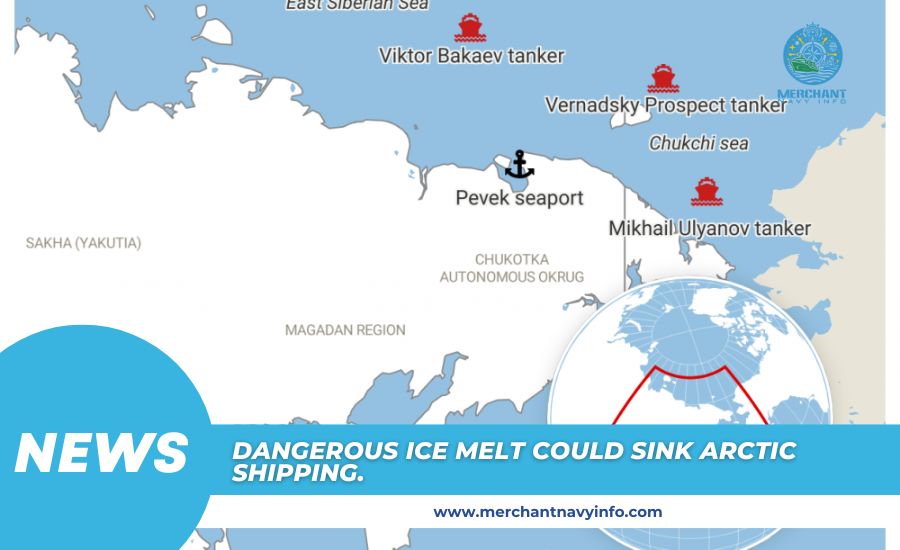
Warmer temperatures were supposed to facilitate shipping in the Arctic. However, thick floating ice caused by localised melt is more dangerous than people realise.
Climate change is thinning Arctic sea ice, which, contrary to conventional wisdom, is making shipping across the Arctic to North America more difficult.
A study published in Nature examined Canada’s Northwest Passage over a 15-year period. It found that localised ice melt caused by global warming has allowed thicker ice from Greenland to flow into choke points in the passage, shortening the time it takes ships to pass through.
“First-year ice is retreating. But that means thicker ice, multi-year ice is becoming more able to flow into these areas,” said lead author Alison Cook, a researcher at the Scottish Institute for Marine Science and the University of Ottawa, in an interview.
Such thick ice risks ships, such as damage or sinking in a collision.
The findings contradict the popular view that the Northwest Passage, an Arctic Ocean waterway connecting the Atlantic and Pacific Oceans, is an increasingly practical option for commercial shipping. It even surprised Cook.
“I did assume that the season length would get longer everywhere, but that’s not the case,” she said.
Research Reveals the Danger
Cook and her colleagues looked at historical ice maps of the Northwest Passage and converted them into season lengths. A season represents the number of weeks that a ship with average ice strength can pass through the passage without taking extra safety precautions.
Four regions saw significant changes. Between 2007 and 2021, the shipping season was shortened by 50% to 70% in three countries. In one country—east of Lancaster Sound—the length of the season increased by 15%.
The shipping season typically lasts 15 to 25 weeks but fluctuates widely between years and regions.
The changes in ice prevented at least one passenger cruise line from sailing through the pass.
What Experts say?
Scenic Luxury Cruises and Tours had sailed through the Northwest Passage in 2022, but “due to the sensitive environment and changing ice and Arctic weather conditions, they redeployed the ships after that season,” said Michelle Aprile, vice president and spokesperson for Coyne PR. Scenic. “They are not currently sailing there or planning to visit the area before the first quarter of 2027.”
According to data from the Canadian Coast Guard and POLITICO’s E&E News, despite the shorter season, the average number of crossings has increased over the past decade.
“In the coming years, the Canadian Coast Guard expects traffic in the Arctic to increase due to increased tourism, commercial shipping and exploration opportunities,” the Canadian Coast Guard said in a statement.
While trends show an increase in the number of flights and a shorter season, there are two explanations for the apparent discrepancy.
First is demand. Shipping companies are looking for alternatives to the narrow and crowded Panama Canal, and adventurous tourists are keen to hike in the Arctic.
Then there’s the multi-year ice. The three areas where the study found shorter shipping seasons are along the northern route of the Northwest Passage. The southern route has been largely unaffected by thicker ice from Greenland.
“The southern route of the Northwest Passage has seen an increase in ships passing through,” Cook explained. “People are looking at the northern part of the Northwest Passage.” It’s shorter. “People want to go that route more than they do the southern route, but they still don’t want to go because of the ice.”
Final verdict
Royal Wagenborg, a Danish maritime logistics company that ships through the Northwest Passage, declined a request for comment, citing “confidential information.”
Stephen Howell, one of Cook’s co-authors and a research scientist at Environment and Climate Change Canada’s climate research unit, said thick ice from the north will continue to flow downriver in the coming decades, endangering ships on the northern route.
“Ten years, twenty years; as long as there’s ice, the danger will continue,” Howell said in an interview.
Julianne Struve, a scientist at the National Snow and Ice Data Center at the University of Colorado Boulder, said rising temperatures will eventually cause even the thickest ice to melt.
“I envision that if we don’t make drastic reductions in greenhouse gas emissions, after 2050 there won’t be as much ice coming from the Arctic Ocean into the [Canadian Arctic Archipelago], so the [Northwest Passage] will be almost ice-free in the summer,” he said.









